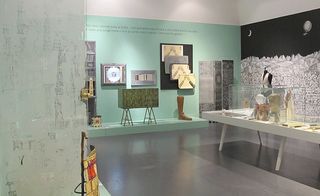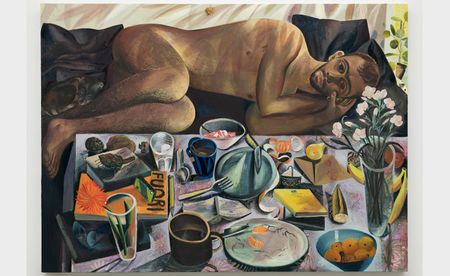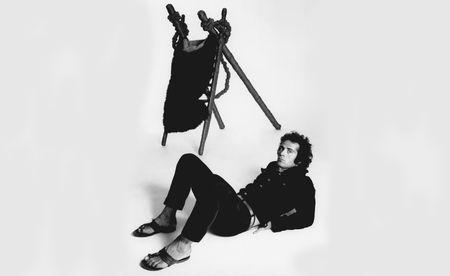Wunderkammer: 100 years of Piero Fornasetti’s ’Practical Madness’ celebrated in Milan

The consummate Italian creative multitasker, Piero Fornasetti, started his career as a painter before plunging into the design and decoration of furniture, interiors, scarves and everyday objects as banal (yet fundamental) as trash cans, ashtrays and umbrella stands. His fantasy-driven flair for drawing, painting and sketching was central to his development as a designer. In fact he was a pioneer, in the 1930s, of elevating ornamentation to the loftier, structural element of design.
The idea crystallised at his studio and production centre in central Milan, where Fornasetti designed, printed and hand-painted his signature black-ink lithographs before applying them to the metal and wood objects - which he also produced. The span of his prolific creative output has now been consolidated for the first time in an impressive new exhibit of more than 1,000 pieces at Milan’s Triennale Design Museum. '100 Years of Practical Madness', designed and curated by Fornasetti’s son, Barnaba, honours the Milanese designer who would have turned 100 this year.
We spoke with Barnaba Fornasetti in Milan to find out more about his father's ever-enduring design legacy...
Why now for a Milan exhibit?
To be honest, it’s been a lifetime that we’ve been trying to organise a Fornasetti exhibit in Milan and there was never a concrete reaction by an institution here. It’s one of those Italian mysteries. Finally with the Triennale, the moment arrived.
As the exhibition's designer, how have you organised the space?
The entryway is dedicated to his work in Milan. There are antique photos showing interiors he created: a pastry shop near the Duomo, the Rinascente department store, a cinema, a police barracks - he frescoed the walls during the war so he wouldn’t be sent away. The only one of these structures that still remains today is the Hotel Duomo.
Explain the first main room.
Here are all of the things that inspired him, the point of his departure. He began with antique books, old prints and images of the past. He was a wonderful designer and could sketch hands and faces very well. But he stole a lot of images from others and he reused them.
Where did he find the face of the woman he used so frequently?
The portrait of Lina Cavalieri was a print he found in an old book. He stole an antique image from the century before, but he made 300 variations on it over the years and created an icon. It became an enormous source of recognition for him and for his work.
What was the first piece of furniture that he designed?
A cabinet in the 1940s. Here you see the three front cupboard doors of that piece. It looks like a collage of letters and clippings from books but every single thing was painted by hand. Every word, even the texture of the walnut wood, was painted. After this, he created a system of printing of lithographs, so that the ink outlines could be copied and then were painted in colour by hand to speed up the process.
Tell us about his studio and what took place there.
His studio was first used for painting, then he became a printmaker and then a producer of objects. Aside from being a genius artist with a flair for fantasy, he was also extremely deft in the technical printing process. Fontana, de Chirico, Campigli, Sassi, Clerici, Caratta, they all came to his studio to print art books, lithographs, limited numbers of art. So he was also a sort of publisher, too. Having all of these artistic personalities around gave him a huge amount of stimulation and inspiration for his own work. When you look at his work you see the influence of so many different artists, from the realists to the metaphysicists to 'Natura Morta' by Morandi.
When did he meet Gio Ponti?
My father had designed a series of printed silk scarves that was presented in a competition held at the Triennale in 1933. Ponti saw them and said, 'Aside from being a great printer, you’re also a great designer. Let’s collaborate on something.' So they began to work on techniques of putting art on everyday objects. But the industry hadn’t really started; they were too modern and anti-conformist. So in the end my father decided to produce the objects himself. He created his company to do that.
What specific projects did Fornasetti and Ponti work on together?
The interiors of several luxury apartments, the Andrea Doria ocean liner and several movie theatres in Milan.
Are there items in the exhibit that have never been seen before?
Yes, several of the designs, paintings and the huge cabinet designed with Ponti, for example. All of it was in the archive.
You’ve also included new items...
I’ve tried to keep a contemporary link. So these furniture pieces are ones I designed myself using old pieces of wood from the lithographs. They were used to print the decorations and prints. They were not usable anymore, so I decided to create a collection of furniture and accessories used with the original zinc plates. It’s a kind of recycling.
What plans do you have for the exhibit after Milan?
We’d like to send it around the world. For years now Milan has been only an importer of exhibitions from other countries. So I believe it’s important that this [exhibition] was born here, the capital of design, and can be exported to other cities later.

Nearly one hundred trays varying in shape and decoration take pride of place in this room

The third room features many of the paintings made by Fornasetti over the course of his life. The display case in the foreground, meanwhile, houses an array of ashtrays, boxes and books

Fornasetti's 'Valigie' umbrella stand is presented in front of the 'Chiavi segrete' (secret keys) wallpaper produced by Cole & Son

From left: 'Strumenti musicali' (musical instruments) table top; 'Cammei' obelisk lamp, mid-1950s; 'Conchiglie' chandelier, hand-made by his wife Giulia using real shells for their house in Varenna on Como Lake; 'Strumenti musicali' chair, 1951; 'Octagonal Mirror'; 'Sole' chairx, 1950s; 'Interno armadio' screen, 1950; brass coat hanger, 1970s; and Piero Fornasetti’s own 'Arlecchino' silk waistcoat Arlecchino, from the 1940s

A vitrine of Fornasetti's curios demonstrates the designer's boundless imagination

Several porcelain plates from one of Fornasetti's most well-known series 'Tema e Variazioni' (theme and variations) are strung across white sheets arching over the gallery space

The monochrome 'Women’s bicycle', 1980s, with leather furnishings hangs above the space

'Obelischi' silk scarf, by Piero Fornasetti, 1939

The 'Lux Gstaad' chair (left), by Barnaba Fornasetti, 2009, and 'Musicale' chair (right), by Piero Fornasetti, 1951

A side table decorated with a variety of sea creatures is an example of how Piero Fornasetti infused art into everyday objects

No surface was out of reach for Fornasetti, who transferred his black and white lithographs onto a plethora of furnishings

A detail of the corridor lined with several cylindrical umbrella stands

'Braccio con bicchiere' tray (above) and 'Marameo' tray (below)

'Duomo Sommerso' depicts the Duomo di Milano submerged underwater on a folding screen

Fornasetti's self-portrait shares exhibition space with the 'Moro' chair, on which a Moorish character is painted

Collections of work from the Fornasetti atelier crowd the exhibition space, neatly grouped by theme: the 'Oggetti con nastro' magazine rack containing pieces from Fornasetti's print archive; 'Ultime notizie' hand-coloured silk pours out of a press imaged on the wall; and lithography proofs printed by Piero Fornasetti for other famous Italian painters like Giorgio De Chirico and Lucio Fontana hang in a cluster

A door to Melchiorre Bega’s architecture firm (far left), made from acid-etched glass and brass, sits between two rooms in the exhibition

Former display samples of table tops (left) from Fornasetti's Milan showroom run along one wall, displayed alongside the designer's 'Angolo spogliatoio' screen, 1955 (right)

Piero Fornasetti stands in front of a wall of plates from the 'Tema e Variazioni' series.
ADDRESS
La Triennale di Milano
Viale Emilio Alemagna, 6
20121 Milan
Wallpaper* Newsletter
Receive our daily digest of inspiration, escapism and design stories from around the world direct to your inbox.
JJ Martin
-
 Masters of midcentury modern design and their creations spotlighted in new book
Masters of midcentury modern design and their creations spotlighted in new book‘Mid-Century Modern Designers’ is a new book from Phaidon celebrating those who shaped the period and their notable creations, from furniture to objects
By Tianna Williams Published
-
 Drafting nine international artists, Gucci’s ‘90 x 90’ project transforms its silk scarf into a creative canvas
Drafting nine international artists, Gucci’s ‘90 x 90’ project transforms its silk scarf into a creative canvasPart of Gucci’s ‘The Art of Silk’ initiative, the project sees nine artists riff on the Italian fashion house’s most memorable motifs, from lush depictions of flora and fauna to its signature horsebit
By Jack Moss Published
-
 Every new Rolex watch unveiled at Watches & Wonders 2025
Every new Rolex watch unveiled at Watches & Wonders 2025Our editors are on the ground at the biggest trade show in the horological calendar, where key industry players take the stage. Here, we spotlight Rolex as it reveals its new wave of watches
By Anna Solomon Published
-
 Inside the unexpected collaboration between Marni’s Francesco Risso and artists Slawn and Soldier
Inside the unexpected collaboration between Marni’s Francesco Risso and artists Slawn and SoldierNew exhibition ‘The Pink Sun’ will take place at Francesco Risso’s palazzo in Milan in collaboration with Saatchi Yates, opening after the Marni show today, 26 February
By Hannah Silver Published
-
 What makes fashion and art such good bedfellows?
What makes fashion and art such good bedfellows?There has always been a symbiosis between fashion and the art world. Here, we look at what makes the relationship such a successful one
By Amah-Rose Abrams Published
-
 Remembering Oliviero Toscani, fashion photographer and author of provocative Benetton campaigns
Remembering Oliviero Toscani, fashion photographer and author of provocative Benetton campaignsBest known for the controversial adverts he shot for the Italian fashion brand, former art director Oliviero Toscani has died, aged 82
By Anna Solomon Published
-
 Distracting decadence: how Silvio Berlusconi’s legacy shaped Italian TV
Distracting decadence: how Silvio Berlusconi’s legacy shaped Italian TVStefano De Luigi's monograph Televisiva examines how Berlusconi’s empire reshaped Italian TV, and subsequently infiltrated the premiership
By Zoe Whitfield Published
-
 Louis Fratino leans into queer cultural history in Italy
Louis Fratino leans into queer cultural history in ItalyLouis Fratino’s 'Satura', on view at the Centro Pecci in Italy, engages with queer history, Italian landscapes and the body itself
By Sam Moore Published
-
 Out of office: what the Wallpaper* editors have been doing this week
Out of office: what the Wallpaper* editors have been doing this weekA snowy Swiss Alpine sleepover, a design book fest in Milan, and a night with Steve Coogan in London – our editors' out-of-hours adventures this week
By Bill Prince Published
-
 Pino Pascali’s brief and brilliant life celebrated at Fondazione Prada
Pino Pascali’s brief and brilliant life celebrated at Fondazione PradaMilan’s Fondazione Prada honours Italian artist Pino Pascali, dedicating four of its expansive main show spaces to an exhibition of his work
By Kasia Maciejowska Published
-
 ‘I just don't like eggs!’: Andrea Fraser unpacks the art market
‘I just don't like eggs!’: Andrea Fraser unpacks the art marketArtist Andrea Fraser’s retrospective ‘I just don't like eggs!’ at Fondazione Antonio dalle Nogare, Italy, explores what really makes the art market tick
By Sofia Hallström Published